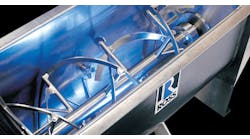Mixing and blending are among the most universal aspects of food production. Whatever food or beverage you can think of, there’s a good chance that somewhere along the line, to make it, something (or many things) had to be mixed or blended.
And with universal application comes universal concerns. Ask suppliers of mixing and blending equipment what their customers want, and they’ll run through the litany of general food processing priorities: sanitation, high throughput, flexibility, consistency, digital capability, etc.
The priorities may be universal, but they’re also changing in emphasis, says Gary Seiffer, sales specialist at EnSight Solutions (www.ensightsolutions.us), owner of the Likwifier brand of high-shear mixers.
“The concerns have shifted, and we have shifted with them,” Seiffer says. “Homogeneous blending in quick order is paramount as food producers look to increase capacities with what they have – all the while upping quality levels.”
According to Matthew Hartman, senior automation sales engineer at Blentech (www.blentech.com), the trend is away from homogeneous, do-it-all equipment and toward more specialization.
Did You Know?
Nancy Corriveau, director of operations for Blentech Corp. was one of the 22 women honored during the first ever Influential Women in Manufacturing Award in 2018? Learn more about what she has contributed to Blentech's operations as well as how you, too, can be a part of the 2019 award class. Visit the Influential Women in Manufacturing website
“We have seen a shift in thinking,” Hartman says. “In the past, we have seen our clients looking for equipment that can do it all. Today we see [them] asking for highly optimized processes designed for a particular family of products to maximize quality and minimize cost at the same time.”
One of the biggest imperatives is high throughput, which can be tricky. As a line’s or plant’s throughput increases, the mixing and blending operations must keep pace. But this can be a problem for two reasons. Mixing and blending have to be done thoroughly and can’t be rushed – at least, not without the right equipment. And mixing and blending usually are inherently batch processes, involving fixed quantities that have to come together in exact proportions.
Bigger batches
One way to increase throughput in batches is simply to increase the batch sizes, which means upgrading the equipment’s capacity. This can be done by using several mixing receptacles, arranged so that a batch is always being worked on, says Ken Langhorn, technical director at Charles Ross & Son Co. (www.mixers.com).
“A buffer tank or a second batch tank can be utilized to provide a steady output,” Langhorn says. “When a change can-style mixer is utilized, multiple interchangeable mix vessels can be utilized to accomplish this. Often, a change can mixer will be operated with three vessels: one mixing, one discharging and one being cleaned and prepped for the next batch.”
However, there are applications where batch mixing and blending just won’t keep pace with production requirements. That’s where inline options come into play. Basically, they offer more capacity with less footprint and less steel.
The magicLAB system from IKA-Works can organize blending process data during lab and pilot tests to ease scaleup to production.
“Processing from an inline perspective provides mainly process oriented advantages,” says Lee Holliday, regional sales manager for IKA-Works Inc. (www.ika.com/en). “For instance, large production volume requirements lend very well to inline processing. Space requirements can become an issue in facilities where several large vessels are needed to meet production demands. The addition of an inline process can significantly reduce the space required, without compromising the quality.
"An additional benefit can be realized in reduced labor related to personnel need for charging raw ingredient or cleaning,” he adds.
Solid strategy
Inline mixing can have processing advantages, especially when a solid, usually a powder, is being combined with a liquid in which it is immiscible (i.e., the powder won’t dissolve in the liquid). This requires the solid and liquid to come together as a suspension, a situation often seen in viscous products such as dips, dressings and sauces.
A common arrangement is an in-line, high-shear mixer that uses a rotor immersed in a pipeline. The difference between the speed of the liquid in the middle of the rotor and its speed at the tip creates shear, or flow force. The shear can be enhanced by the addition of a stator, a sleeve that encloses the rotor and heightens the liquid’s flow as it exits. The high shear creates an environment in which powder or immiscible liquid can be dispersed with maximum efficiency. (High-shear mixing can also be done on a batch basis, with the rotor mounted on the bottom of the tank.)
Once the product has been blended, a common way to keep it that way while it’s being passed along for further processing or packaging is to put it through high-shear pumps. However, those can be hard to clean, making product changeovers more problematic, and many processors are trying to do without them, Seiffer says.
The Likwifier from EnSight Solutions can eliminate the need for shear pumps after blending.
“In the case of high-speed, high-shear blending, our customers want to reduce or eliminate shear pumps after blending, and our Likwifier does that,” he says.
Thermal time
It’s common for mixing and blending equipment to heat or cool product during the process. The temperature change often is accomplished by “jacketed” mixing vessels that have a layer between the outer and inner walls, through which thermal fluid flows.
Heating and cooling product this way is energy-efficient and reliable from a safety standpoint, to the point where it can be established as a critical control point in a HACCP plan. When done gently, cooling can also help stabilize ingredients, Seiffer says.
“If we take the word cooking and replace it with temperature stabilization, we get many more applications,” he says. “Keeping product cool to avoid breaking down or separation of ingredients is huge, and we do it very well.”
Another way to cool product during mixing and blending is to introduce a cooling agent like carbon dioxide or nitrogen. This is commonly done with ground meat, which is cooled as much as possible to make it easier to form into shapes like patties and nuggets.
Scott Robertson, a vice president with RMF Steel (www.rmfworks.com), says some end users want cooling to take place as fast as possible, to increase throughput. The problem is that if the cooling takes place too fast, it could stiffen the ground meat or other product to the point where it might damage the mixing equipment. The best way to prevent this, he says, is to monitor the power that the equipment is drawing.
“Just keeping track of the temperature is something [end users] do, but you can also monitor the amps that the drive is using up. If those amps get too high, you can shut down the mixer before something gets damaged,” Robertson says. “When they’re using CO2 or nitrogen to chill down the meat, it gets cold and that product gets difficult to move. You don’t want to take it to where something might get damaged inside the mixer.”
Data enters the mix
Monitoring and acting on operational parameters are growing priorities for mixing and blending equipment, suppliers say. As with most other types of food processing equipment, it’s expanding its digital capacity in terms of generating and receiving data, storing formulations and other information, and even joining the industrial internet of things.
Langhorn says the most significant improvements to Ross mixing equipment have been to the control systems. “Not only do they monitor critical parameters such as temperature, pressure, agitator speeds and motor loads, but they also have the ability to prompt operators at critical stages of the batch or even call for automated delivery of the batch ingredients,” he says.
EnSight can be “as advanced as our clients desire” in automation, Seiffer says. “We can monitor and maintain temperatures. We can raise and lower in different times of a process. As an example, in our mixer/blender series, where cook times are longer, we can start at low temps to achieve specific results and then raise to a much higher temperature to set a product or prepare for hot-fill application.”
Digital capacity doesn’t just extend to operations. Holliday says that IKA-Works has developed magicLAB, which can capture and export critical trending data for an easier transition from lab to pilot phase to production. “Information such as tip speed, temperature, torque and time all can be collected and downloaded for any development process,” he says.
Because they are so fundamental to many food formulations and have such a direct impact on food quality, demands and expectations for mixing and blending often reverberate back up the supply chain from the consumer.
As Seiffer puts it: “I often feel like I am selling to the end user more than the processor.”


